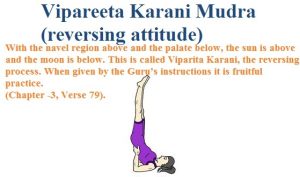Vipareeta Karani Mudra
Introduction
Vipareeta Karani Mudra is a rejuvenating yogic hand and body gesture that enhances energy circulation, relaxation, and balance in the body and mind. It is derived from Vipareeta Karani Asana (Legs-Up-the-Wall Pose) in yoga and focuses on reversing energy flow to restore vitality.
The term comes from Sanskrit:
Vipareeta: Inverted or reversed
Karani: Action or gesture
Overall Purpose:
This mudra helps balance prana, reduce fatigue, calm the nervous system, and support emotional and mental well-being.
Meaning
Vipareeta: Reversal of usual energy flow
Karani: Action or mudra
Overall Meaning:
Vipareeta Karani Mudra reverses stagnant energy, revitalizes the body, and promotes mental and emotional equilibrium.
How to Perform / Practice
Assume vipareeta karani asana. Bring the legs over the head so that the eyes look straight up at the feet. Close the eyes and relax the whole body.
This is the starting position.
Fix the awareness at manipura chakra in the spine, directly behind the navel.
Inhale slowly and deeply with ujjayi pranayama.
Simultaneously, feel the breath and consciousness moving from manipura to vishuddhi chakra.
While exhaling, maintain the awareness at vishuddhi.
At the end of exhalation, immediately bring the awareness back to manipura and repeat the same process.
Benefits
Physical Benefits:
Promotes blood circulation and lymphatic drainage.
Reduces fatigue, heaviness in legs, and lower body swelling.
Relieves tension in legs, lower back, and feet.
Supports endocrine and nervous system balance.
Mental & Emotional Benefits:
Calms stress, anxiety, and mental fatigue.
Enhances clarity, emotional stability, and rejuvenation.
Improves sleep quality when practiced in the evening.
Energetic / Spiritual Benefits:
Reverses stagnant prana, promoting smooth energy flow.
Balances Ida and Pingala nadis, fostering mental clarity.
Encourages deep relaxation and energetic rejuvenation.
Contraindications
Avoid if experiencing serious spinal or neck injuries.
Not recommended for glaucoma, uncontrolled hypertension, or heart conditions without medical advice.
Avoid if pregnant unless modified under supervision.
Discontinue if discomfort, dizziness, or strain occurs.
Anatomy & Physiology
Muscles: Engages legs, lower back, and intrinsic hand muscles for mudra positioning.
Joints: Hip and knee extension/flexion (if legs elevated) and slight finger flexion.
Nervous System: Activates parasympathetic system, reducing stress and promoting relaxation.
Circulation: Enhances venous return and lymphatic flow; improves energy and oxygen supply to the brain.
Kinesiology
Improves postural alignment during inversion or semi-inversion.
Encourages muscular relaxation in lower limbs while supporting spinal alignment.
Supports energy flow through upper and lower body channels.
Neurology
Stimulates brain regions related to relaxation, stress reduction, and attention.
Balances autonomic nervous system, reducing sympathetic overactivity.
Enhances neural regulation of circulation and energy distribution.
Duration of Practice
Daily Practice: 10–20 minutes; can be extended to 30 minutes for therapeutic purposes.
Short Practice: 5–10 minutes for relaxation and energy refresh.
Can be combined with pranayama or meditation for deeper rejuvenation.
Counter Mudra
Gentle stretching or restorative postures like Supta Baddha Konasana can follow practice.
Avoid prolonged inversion in case of dizziness; resume upright position gradually.
Conclusion
Vipareeta Karani Mudra is a rejuvenating hand and body gesture that balances prana, improves circulation, and promotes emotional and mental calmness. Regular practice reduces fatigue, stress, and stagnation while enhancing energy flow, relaxation, and overall well-being.
FAQ
Q1: Can beginners practice Vipareeta Karani Mudra?
A: Yes, start with 5–10 minutes and gradually increase duration.
Q2: Can it improve sleep and relaxation?
A: Yes, it calms the nervous system and supports restorative sleep.
Q3: Can it be combined with other mudras or asanas?
A: Yes, it can be combined with pranayama and meditation for enhanced benefits.
Q4: Is it suitable for people with high blood pressure or eye issues?
A: Consult a physician before practice if glaucoma, hypertension, or cardiovascular issues are present.
References
Swami Satyananda Saraswati, Mudras for Healing and Transformation.
Iyengar, B.K.S., Light on Yoga.
Saraswati, S., Pranayama and Mudras in Yoga Therapy.
Fishman, L., Yoga for Emotional Balance.
Lad, V., Ayurveda: The Science of Self-Healing.
Journal of Bodywork and Movement Therapies, 2018; 22(4): Effects of Hand Mudras on Mental and Physiological Functions.

